
Very Small Array Photos
(Click on thumbnail to download full picture)
 The Very Small Array
The Very Small Array
(Click on thumbnail to download full picture)
Attn. Journalists and Photo Editors: please check our Fair Use Policy before reproducing any of these images. Thank you.
  |
While fundraising efforts for our ambitious Array2k project continue, we have received grants from the American Astronomical Society, the Second Foundation, and the ARRL Foundation, to begin construction of an eight-dish prototype. Dubbed the Very Small Array (VSA), this 1296 MHz antenna system is slowly taking shape in the backyard of executive director H. Paul Shuch's rural Pennsylvania home. It will be used to test reception of our ham radio Moonbounce Beacon. |
| Here civil engineering student Timothy Wentz is staking out the precise location for the first of the VSA's eight dishes. | 
|
| Come spring thaw, we were able to begin digging holes for the mounting pipes. Seen here is a 24 inch diameter auger being aligned with the first stake. | 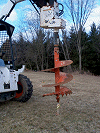
|
| Fortunately, the ground was soft, and the soil moist from the recently melted winter snows. The first hole was easily dug to a depth of 42 inches... | 
|
| The last of the eight holes for the VSA was drilled on 28 February 2002. Though technically still Northern hemisphere winter, temperatures of a comfortable +2 degrees Celsius prevailed. | 
|
| With all eight holes in place, it appears as though Dr. Shuch's back yard has been attacked by an alien race of giant gophers! | 
|
| For antenna masts, the VSA is using eight twelve-foot lengths of 4" OD Schedule 40 galvanized steel pipe. | 
|
| The patio thermometer shows that it was comfortably above freezing when we began to plant the eight antenna masts in their respective holes in the ground. | 
|
| Each antenna mast is set on concrete blocks in the hole. The pipe is drilled, and a length of steel reinforcing bar passed through it, to prevent the mast from twisting in its concrete base. | 
|
| Guy wires and bubble levels help the workers to true the masts. The levels need to be placed near the top of the pipe, spaced ninety degrees apart. | 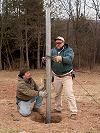
|
| Magnetic levels, which secure themselves to the steel pipes, make the job of leveling the antenna masts much easier. | 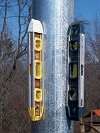
|
| The guy wires, attached to wooden stakes in the ground, are temporary. They hold the mast in position while the concrete is being poured. | 
|
| The concrete is mixed with water, six bags at a time. Each wheelbarrowful of concrete dumped into the holes weighs about 500 pounds. | 
|
| Each antenna mast will receive a total of 14 bags of mixed concrete, totaling around 1200 pounds. This design will allow the antennas to survive sustained winds of up to 90 MPH. | 
|
| Each hole is filled with concrete to within a few inches of ground level. This allows topsoil to be shoveled over the concrete, and grass to grow right up to the antenna mast. | 
|
| As of the first day of March, 2002, it was four masts up, four to go. The strings verify the proper placement of the masts, crossing at the array phase center, at exactly a 90 degree angle. | 
|
| Just one day later, all eight antenna masts were up, awaiting being trimmed to the appropriate heights. | 
|
| Cutting the masts down to size. A string level was used to determine the trim line for each mast, so that all dishes will be at the same absolute height. | 
|
| Forty Arbor Vitae being delivered to the VSA site. These trees, now only eight feet tall, will grow to a height of some twenty feet or more, completely blocking the antennas from view. | 
|
| Placing the Arbor Vitae around the poles of the VSA, in preparation for digging the holes and planting them. | 
|
| Workers planting the last of a ring of trees around the eight antenna masts of the Very Small Array. | 
|
| The first VSA antenna is clearly visible, viewed through the line of trees. Within one to two years, once the trees have filled in, none of the dishes will be visible from anywhere on the adjacent property. See this editorial on Being a Good Neighbor. | 
|
| Lewis Carroll wrote about painting the roses red. Through a different looking glass, here is Dr. SETI painting the dishes green. | 
|
| Painted with Adirondak Green exterior latex house paint, and viewed through VSA Grove, the first dish blends nicely into the background. | 
|
| The Flag of Earth flys proudly from the first dish of the Very Small Array. It underscores the global nature of The SETI League, the VSA, and the entire SETI enterprise. | 
|
| Seven more az-el mounts (reminiscent of the Pleiades, the constellation also known as the Seven Sisters) are installed on their VSA masts, awaiting delivery of the remaining seven dishes. | 
|

| The rapidly growing VSA, as viewed from above (left) and below (right). | 
|
| The next step was to mount offset feedhorn-support tripods on the reflectors. As these dishes are designed for non-blocked apertures, the feed points appear significantly off-center. | 
|
| A view from ground level shows how the grove of arbor vitae and the selected color scheme combine to help mask the eight dishes of the VSA from view. | 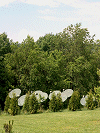
|
| VSA volunteers Steve Berger and Jack Weaver, using a rented back-hoe to dig the main cable trench. | 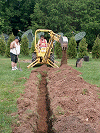
|
| Two runs of PVC conduit, one carrying coaxial cables and the other for power wiring, are laid in the 33.5 meter long trench. | 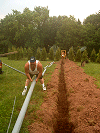
|
| Conduit from each of the dishes, as well as the main conduit run into the station, connects to the main circuit box at the center of the array. | 
|
| Inside the VSA's main junction box, a jumble of cables awaits the installation of a plethora of connectors. | 
|
|

|
|

|
|
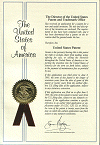
|
|

|
|

|
|

|
|
|
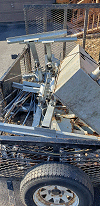
|
|

|
Click here for lots more pictures.
email the Webmaster | entire website copyright © The SETI League, Inc.; Maintained by Microcomm this page last updated 8 August 2024 |
Top of Page |